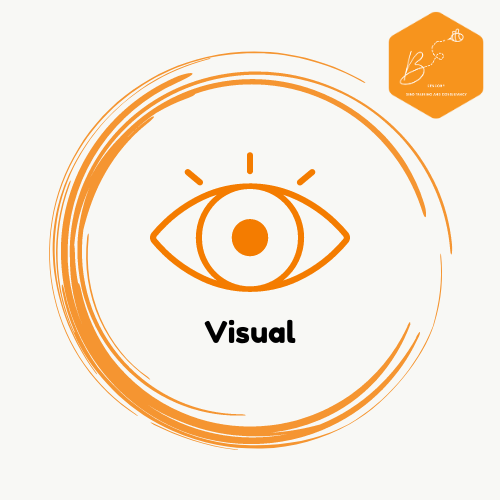Signs and Symptoms of Visual Processing Difficulties

Signs and Symptoms
It is essential for professionals and caregivers to be able to identify when somebody is having visual processing difficulties. As well as sensory profiling people to identify their sensory difficulties, being able to recognise the signs of sensory needs is vital for effective management.

Too Much Information
Signs of too much visual sensory information, especially in a classroom setting, can vary depending on individual sensitivities and coping mechanisms. However, some common signs to watch out for include:
- Overstimulation: Students may become visibly overwhelmed or agitated in response to excessive visual stimuli. This could manifest as fidgeting, covering their eyes, or attempting to retreat from the environment.
- Difficulty Focusing: Too much visual information can make it challenging for students to concentrate on tasks or instructions. They may appear distracted, have difficulty maintaining eye contact, or exhibit a short attention span.
- Heightened Anxiety: Excessive visual input can trigger feelings of anxiety or stress in sensitive individuals. Look for signs of increased heart rate, shallow breathing, or nervous behaviors such as nail-biting or pacing.
- Physical Discomfort: Students may experience physical discomfort such as headaches, eye strain, or fatigue when exposed to bright lights, cluttered visual environments, or flickering screens for prolonged periods.
- Behavioural Changes: Pay attention to changes in behavior, such as irritability, restlessness, or mood swings, which may indicate that a student is struggling to cope with overwhelming visual sensory input.
- Avoidance Behaviors: Some students may try to avoid or escape from environments with excessive visual stimuli by seeking refuge in quieter or less visually stimulating areas of the classroom or school.
- Decreased Participation: Students who are overwhelmed by visual sensory information may withdraw or become disengaged from classroom activities, leading to decreased participation and academic performance.
- Sensory-Seeking Behaviors: On the other hand, some students may engage in sensory-seeking behaviors as a coping mechanism to regulate their sensory experiences. This could include excessive touching or exploring of visual materials, difficulty staying seated, or seeking out bright or visually stimulating objects.
- Emotional Dysregulation: Too much visual sensory information can disrupt emotional regulation, leading to outbursts, meltdowns, or emotional instability in some students.
- Physical Symptoms: In severe cases, students may experience physical symptoms such as nausea, dizziness, or sensory overload headaches as a result of exposure to overwhelming visual stimuli.
Too Little Information
Signs of too little visual sensory information, often referred to as visual understimulation, can also have noticeable effects on individuals, especially in learning environments like classrooms. Here are some signs to watch out for:
- Lack of Engagement: Students may appear disinterested or disengaged in classroom activities, showing minimal response to visual stimuli such as instructional materials, presentations, or visual aids.
- Difficulty Maintaining Attention: A lack of visual stimulation can lead to difficulty maintaining attention and focus. Students may seem easily distracted, have trouble following along with lessons, or exhibit signs of daydreaming.
- Limited Exploration: Students may demonstrate a lack of curiosity or motivation to explore their environment visually. They may not actively seek out visual information or show little interest in visually stimulating materials or displays.
- Boredom: A visually under-stimulating environment can contribute to feelings of boredom or apathy among students. They may express a lack of enthusiasm for classroom activities or appear lethargic and unmotivated.
- Slow Processing Speed: Insufficient visual input can impact processing speed, causing students to take longer to comprehend and respond to visual information presented in class. They may require additional time to process instructions or visually presented content.
- Limited Creativity and Imagination: Visual understimulation can hinder creativity and imaginative thinking. Students may struggle to generate ideas, problem-solve visually, or engage in imaginative play or artistic expression.
- Restlessness: Some students may exhibit restlessness or fidgetiness in response to a lack of visual stimulation. They may seek out alternative ways to stimulate their senses, such as tapping pencils, doodling, or daydreaming.
- Difficulty with Visual Tasks: Students may struggle with visual tasks such as reading, writing, or interpreting visual information. They may display poor visual tracking skills, difficulty discriminating between visual stimuli, or challenges with visual-motor coordination.
- Low Energy Levels: A visually under-stimulating environment can contribute to low energy levels and fatigue among students. They may appear sleepy, sluggish, or unenergetic during class time.
- Decreased Motivation: Students may demonstrate decreased motivation to participate in classroom activities or complete assigned tasks in a visually under-stimulating environment. They may lack initiative or enthusiasm for learning.
It's essential to address visual understimulation by providing a visually rich and stimulating learning environment that fosters engagement, curiosity, and active participation. Incorporating colorful visuals, interactive materials, hands-on activities, and stimulating classroom displays can help provide the necessary visual input to support learning and cognitive development. Additionally, encouraging movement, exploration, and sensory experiences can further enhance student engagement and motivation.




